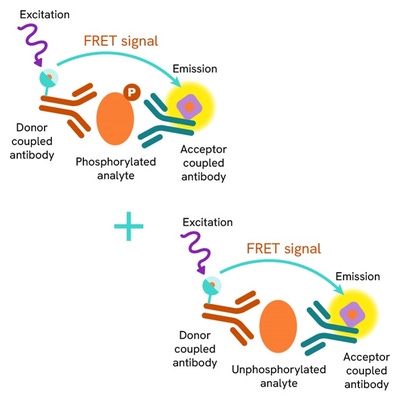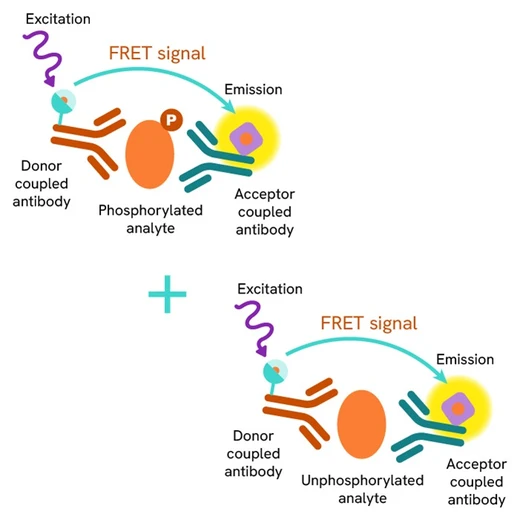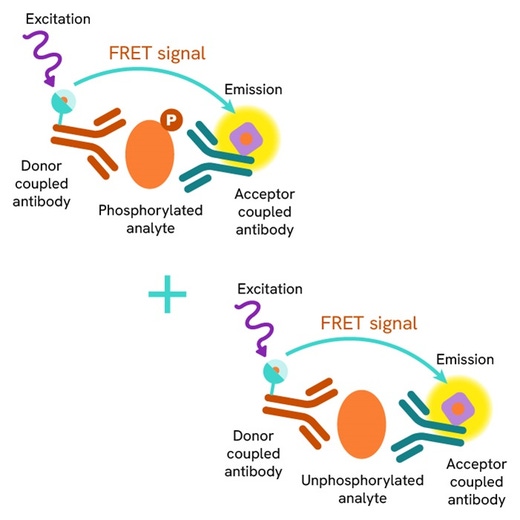

HTRF Human and Mouse Total Cereblon Detection Kit, 500 Assay Points








| Feature | Specification |
|---|---|
| Application | Cell Signaling |
| Sample Volume | 16 µL |









Product information
Overview
The Total Cereblon cellular assay measures the expression level of the E3 ubiquitin ligase Cereblon (CRBN) in cells.
Cereblon is a ubiquitously expressed protein which functions as a substrate recognition subunit within the CRL4-CRBN E3 ubiquitin ligase complex, and targets specific proteins for proteolysis through the Ubiquitin Proteasome System (UPS).
Cereblon plays a key role in normal limb outgrowth, normal cell proliferation and metabolism, and in memory and learning.
Cereblon is also the primary direct target of the immunomodulatory drugs (IMiDs) Thalidomide, Pomalidomide, and Lenalidomide, that are all FDA approved drugs for the treatment of multiple myeloma. Interestingly, IMiDs have recently been derived into PROTAC molecules in order to direct degradation of undesired proteins by the UPS.
How it works
Total Cereblon assay principle
The Total Cereblon assay quantifies the expression level of Cereblon in a cell lysate. Unlike Western Blot, the assay is entirely plate-based and does not require gels, electrophoresis, or transfer. The Total Cereblon assay uses two labeled antibodies, one coupled to a donor fluorophore and the other to an acceptor. Both antibodies are highly specific for a distinct epitope on the protein. In the presence of Cereblon in a cell extract, the addition of these conjugates brings the donor fluorophore into close proximity with the acceptor and thereby generates a FRET signal. Its intensity is directly proportional to the concentration of the protein present in the sample, and provides a means of assessing the protein's expression under a no-wash assay format.

Total Cereblon two-plate assay protocol
The two-plate protocol involves culturing cells in a 96-well plate before lysis, then transferring lysates into a 384-well low volume detection plate before the addition of Total Cereblon HTRF detection reagents. This protocol enables the cells' viability and confluence to be monitored.

Total Cereblon one-plate assay protocol
Detection of Total Cereblon with HTRF reagents can be performed in a single plate used for culturing, stimulation, and lysis. No washing steps are required. This HTS designed protocol enables miniaturization while maintaining robust HTRF quality.

Assay validation
Assessment of Cereblon protein levels in various human and mouse cell lines
The human HEK293, HepG2, HeLa, and Jurkat cell lines, as well as the mouse NIH-3T3 cell line, were seeded in 96-well plates at different cell densities and cultured for 24h. The cells were then lysed with supplemented lysis buffer #4, and the cell lysates were analyzed for their total Cereblon protein levels by transferring 16 µL of samples into a 384-well low volume white microplate and adding 4 µL of the HTRF Total Cereblon detection antibodies. The HTRF signal was recorded after an overnight incubation.

Knockdown of CRBN expression by siRNA experiments
HEK293 cells were plated in a 96-well plate (50,000 cells/well) and cultured for 24h. The cells were then transfected either with a siRNA specific for Cereblon or with a siRNA specific for VHL (Von Hippel–Lindau), as well as with a negative control siRNA. After a 48h incubation, the cells were lysed and 16 µL of lysates were transferred into a 384-well low volume white microplate, before the addition of 4 µL of the HTRF Total Cereblon detection antibodies. The HTRF signal was recorded after an overnight incubation.
As expected, cell transfection with the Cereblon siRNA induced the knockdown of CRBN expression as highlighted by the 76% signal decrease, while no signal modulation was observed when cells were transfected with the VHL siRNA or with the negative siRNA.

Stabilization of Cereblon protein levels by immunomodulatory drugs (IMiDs)
HEK293 cells were seeded in a 96-well plate (50,000 cells/well) and incubated for 6h. The cells were then treated with 0.1 and 10 µM of the IMiDs Thalidomide (TOCRIS, #0652), Lenalidomide (TOCRIS, #6305), and Pomalidomide (TOCRIS, #6302). After an overnight incubation, the cells were lysed and 16 µL of lysates were transferred into a 384-well low volume white microplate, before the addition of 4 µL of the HTRF Total Cereblon detection antibodies. The HTRF signal was recorded after an overnight incubation.
As expected, cell treatment with Thalidomide, andwith its derivatives Lenalidomide and Pomalidomide, resulted in stabilization and accumulation of Cereblon protein levels through the inhibition of Cereblon ubiquitination and degradation (Liu et al., A novel effect of thalidomide and its analogs: suppression of cereblon ubiquitination enhances ubiquitin ligase function; FASEB J. 2015 Dec; 29(12): 4829–4839).

HTRF total Cereblon assay compared to Western Blot
HEK293 cells were cultured in a T175 flask in complete culture medium at 37°C-5%, CO2. After a 48h incubation, the cells were lysed with 3 mL of supplemented lysis buffer #4 (1X) for 30 minutes at RT under gentle shaking.
Serial dilutions of the cell lysate were performed using supplemented lysis buffer, and 16 µL of each dilution were transferred into a low volume white microplate before the addition of 4 µL of HTRF total Cereblon detection reagents. Equal amounts of lysates were used for a side by side comparison between HTRF and Western Blot.
Using the HTRF total Cereblon assay, only 500 cells/well were enough to detect a significant signal, while 4,000 cells/track were needed to obtain a minimal chemiluminescent signal using Western Blot. Therefore in these conditions, the HTRF Total Cereblon assay was 8 times more sensitive than the Western Blot technique.

Simplified pathway
Role of Cereblon in the CRL4-CRBN E3 ubiquitin ligase complex
Cereblon, also known as CRBN, is a ubiquitously expressed protein of 442 amino-acids (55 kDa).
CRBN interacts with DNA damage-binding protein-1 (DDB1), Cullin 4 (Cul4), and the regulator of Cullins 1 (RoC1) to form a functional E3 ubiquitin ligase complex. In this complex, CRBN functions as a substrate recognition subunit and targets proteins for proteolysis through a ubiquitin-proteasome system (UPS). This E3 ubiquitin ligase complex can therefore achieve different cellular responses by targeting different substrates.
CRBN expression in the brain is associated with memory and learning processes. The nonsense mutation (R419X) is responsible for nonsyndromic mental retardation.
CRBN also ensures normal cell proliferation and metabolism by regulating the function of ion channels.
Furthermore, Cereblon is the primary direct target of the immunomodulatory drugs (IMiDs) Thalidomide, Pomalidomide and Lenalidomide, that are all FDA approved drugs for the treatment of multiple myeloma. These drugs induce ubiquitination and degradation of the lymphoid transcription factors IKZF1 and IKZF3 via the CRBN E3 ubiquitin ligase.

Specifications
| Application |
Cell Signaling
|
|---|---|
| Brand |
HTRF
|
| Detection Modality |
HTRF
|
| Lysis Buffer Compatibility |
Lysis Buffer 1
Lysis Buffer 4
Lysis Buffer 5
|
| Molecular Modification |
Total
|
| Product Group |
Kit
|
| Sample Volume |
16 µL
|
| Shipping Conditions |
Shipped in Dry Ice
|
| Target Class |
Phosphoproteins
|
| Technology |
TR-FRET
|
| Therapeutic Area |
Inflammation
Neuroscience
Oncology & Inflammation
|
| Unit Size |
500 assay points
|
Video gallery
Resources
Are you looking for resources, click on the resource type to explore further.
Uncover protein degradation mechanisms with our no-wash assay platforms
Discover the versatility and precision of Homogeneous Time-Resolved Fluorescence (HTRF) technology. Our HTRF portfolio offers a...
This guide provides you an overview of HTRF applications in several therapeutic areas.


Loading...
How can we help you?
We are here to answer your questions.






























